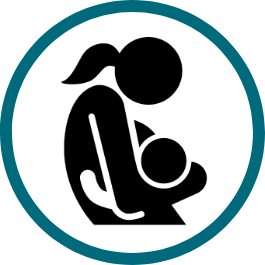Complementary feeding can prevent acute and chronic malnutrition, an indirect cause of 45% of child deaths.1Fact Sheet: Infant and young child feeding
World Health Organization
September 2016 This is a set of habitual behaviors a caregiver must practice every day, starting when a baby is 6 months, through 23 months of age.

Complementary Feeding
Caregivers feed adequate amounts of diverse, nutritious, age appropriate foods to children from 6 to 23 months (inclusive), while continuing to breastfeed
Key Points from Global Research
- Facilitating caregiver understanding of the need for timely introduction of age-appropriate foods and liquids beginning at 6 months can encourage these behaviors and contribute to the growth, health and development of the young child.
- Improving caregiver knowledge on when to start feeding, what to feed, and how often to feed; coupled with access to nutrient-rich, diverse foods can ensure that children are well-fed and have the opportunity for optimal growth and development.
Behavior Profile Sample: Complementary Feeding
A Behavior Profile is a summary analysis of each behavior. This sample draws from global evidence and illustrates the result of using the Create Behavior Profiles Tool to analyze factors, supporting actors and strategies and to ensure logical pathways exist between strategies proposed and factors related to the practice of the behavior. This sample may be used as a starting point or reference for creating Behavior Profiles.
| Improve maternal and child survival | |
|
Caregivers feed adequate amounts of diverse, nutritious, age appropriate foods to children from 6 to 23 months (inclusive), while continuing to breastfeed Indicator: Percentage of breastfed children age 6-23 months fed four or more food groups and the minimum meal frequency
|
Behavior Analysis |
Strategy | ||
|---|---|---|---|
STEPSWhat steps are needed to practice this behavior?
Click on any box |
FACTORSWhat factors may prevent or support practice of this behavior? These should be analyzed for each country context.StructuralAccessibility: Many households lack sufficient quantity and diversity of foods to feed child the required meals Service Provider Competencies: Providers lack the information and skills needed to effectively counsel caregivers on complementary feeding SocialFamily and Community Support: Heads of household and other family members often do not see the need to prepare "special" food for infant child Gender: Often certain foods are reserved for men or heads of household Norms: Some cultural and traditional practices promote a hands-off attitude toward feeding the young child InternalKnowledge: Link between optimum feeding practices and children's healthy growth and development are not well understood Knowledge: Many caregivers have insufficient information on when to initiate, what and how much food to give, and how to feed |
SUPPORTING ACTORS AND ACTIONSWho must support the practice of this behavior?InstitutionalPolicymakers: Leverage and collaborate with private sector to expand access to a variety of options for nutrient rich foods Policymakers: Create nutrition safety net programs or conditional cash transfer programs in food insecure areas Policymakers: Create national nutrition policy that integrates complementary feeding into the training and supervision of health workers on child health Providers: Counsel caregivers and household members on when, how, and how much to feed the infant children, including demonstrations CommunityCommunity Leaders: Promote a variety of farming practices and prioritization of the young child's diet to ensure availability of adequate and nutritious foods for infant children HouseholdFamily Members: Support prioritization of food and active feeding style of infant or young child |
POSSIBLE PROGRAM STRATEGIESHow might we focus our efforts based on this analysis?Enabling EnvironmentPolicies and Governance: Create multi-sectoral National Nutrition Policies that emphasize nutritious agricultural production and practices Policies and Governance: Enact food security programs that include Conditional Cash Transfers or Vouchers or Nutrition Safety Net programs Systems, Products and ServicesQuality Improvement: Train and provide refresher training on complementary feeding practices among community and facility-based providers Demand and UseAdvocacy : Use tools like the length mat to begin to illustrate linear growth and discuss the connection with quality of diet Communication: Conduct community nutrition education programs to promote the "cost-benefits" of complementary feeding Collective Engagement: Facilitate family and community dialogue including reflection on fatherhood, to address inequitable food division in the household Skills Building: Offer cooking classes at a variety of venues frequented by mothers of young children (e.g. essential food markets, community events, etc.) |
Global Status of Accelerator Behavior
Indicator: Percentage of breastfed children age 6-23 months fed four or more food groups and the minimum meal frequency
The DHS Program Indicator Data API, The Demographic and Health Surveys (DHS) Program


 The Manoff Group was acquired by JSI in 2022.
The Manoff Group was acquired by JSI in 2022.